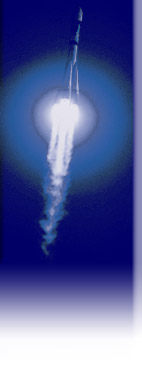

 |
 |

Globalstarís second-generation satellites are encapsulated and ready for installation on their Starsem Soyuz launcher
This action image shows the Soyuz ST payload fairing (at left) being moved into place around the six Globalstar second-generation satellites. These spacecraft are installed on a cone-shaped dispenser that has been mated to the Fregat upper stage, whose spherical tanks are covered with foil protection (in the foreground, at right).
January 28, 2013
Launcher build-up for the concluding Soyuz mission currently contracted with Starsem from Baikonur Cosmodrome is entering its final phase following the integration of its upper composite element – consisting of six Globalstar satellites, their dispenser system, the payload fairing and Fregat upper stage.
The upper composite encapsulation process is highlighted in these two photos at Baikonur Cosmodrome.†At top, the Soyuz ST payload fairing is moved on rails in Starsemís UCIF clean room, positioning it around the cluster of six Globalstar satellites. An end-on view shows the integrated upper composite element (bottom photograph).
In the Cosmodrome’s Upper Composite Integration Facility (UCIF) operated by Starsem, the protective Soyuz ST payload fairing was moved into place this weekend around the mission’s cluster of second-generation Globalstar spacecraft, which are installed on a conical-shaped dispenser and mounted atop the Fregat stage.
The encapsulated upper composite is now ready for transfer to the launch site’s MIK 40 launch vehicle assembly and integration facility for mating with the basic three-stage Soyuz.
The ST26 mission – designating Starsem’s 26th Soyuz flight operated under the affiliate’s responsibility since 1999 – is scheduled for February 5. After liftoff from Baikonur Cosmodrome on the desert steppe of Kazakhstan, the Soyuz will deploy its Globalstar satellites during a 1-hr. 40-min. flight profile.
Weighing approximately 700 kg. each, the three-axis stabilized Thales Alenia Space-built spacecraft have a trapezoidal main body with two solar arrays. To be operated from low-Earth orbit, they are fitted with 16 transponders from C-band to S-band, and 16 receivers from L-band to C-band. Their 15-year design life is twice that of Globalstar’s predecessor first-generation spacecraft.
Starsem and Arianespace have played a key role in the deployment of Globalstar’s constellation for mobile satellite voice and data services. A total of 18 second-generation satellites have been lofted to date on Baikonur Cosmodrome Soyuz missions performed in October 2010, July 2011 and December 2011. They were preceded by eight Starsem missions from 1999 to 2007 that orbited 32 first-generation Globalstar satellites, which weighed 450 kg. each.
For additional information on this mission, read the Launch Kit.

